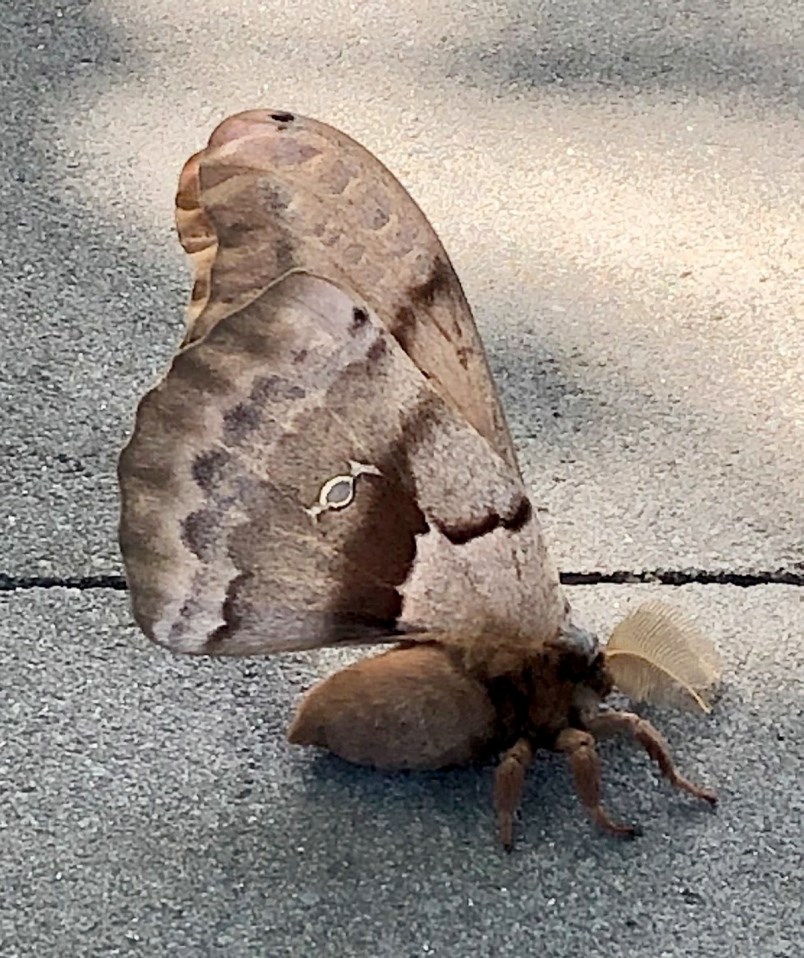Chantal Contorines was walking to her car when her daughter Sofia spotted an enormous insect on the pavement under a tree.
“What is that, Mom?” asked the nine-year-old.
Contorines didn’t have a clue. She was looking at a creature that appeared to be a cross between a moth and a tarantula.
“We carefully approached it not knowing what it really was and it was actually incredible,” Contorines said Friday. “It was beautifully ugly. It really was gigantic. It was probably the size of my hand and it was just kind of sitting there with its wings up.”
Not wanting to get too close, Contorines zoomed in for a photo, then ran back to her car, closed the doors and started the engine. “We looked at the picture afterwards when we got home and we were safe,” she said with a laugh.
Contorines posted the photo on the Oak Bay Local Facebook page, asking for help identifying what turned out to be a harmless Polyphemus moth.
“The comments on Oak Bay Local were funny,” she said. “They were torn between ‘this is something beautiful’ and ‘this is something that you should burn your house down if you ever see it.’ ”
“That critter could take out my winter wardrobe with one bite,” wrote one woman.
“Quick … Hide your cashmere … it looks hungry,” wrote another.
Joel Gibson, curator of the entomology collection at the Royal B.C. Museum, said the Contorines moth is a particularly rotund male.
“It looks like a chunky boy, as my kids would say.”
Polyphemus moths are not exactly common, but they are found in this area, said the entomologist. They are palm-sized, with a wing span of 10 to 15 centimetres.
“If you find one of them with the wings spread out, it’s the size of your hand,” said Gibson. “When you find one on the side of your house, it’s like: ‘Oh, that’s bigger than I thought.’ ”
Polyphemus moth are never found in huge numbers, he said. “You don’t get huge swarms of them like the little white cabbage butterflies you see in your garden. It’s always just one of them and it’s kind of scary.
“But there’s no reason to be afraid. They’re not even a threat. Like all butterflies and moths, they couldn’t bite if they tried. They don’t have mouth parts that bite.”
The moths might be found on an oak tree, eating leaves. But they won’t wipe out crops or trees, said Gibson.
Adult Polyphemus moths are only out at this time of year, from May until July. They live for a couple of weeks, then they lay eggs. The larvae are big fat caterpillars. By fall, the caterpillars turn into chrysalises and they’ll be stuck up under a tree all winter until they hatch out, said Gibson.
“You only get one batch of adults a year around here.”
The museum’s collection has 8,000 to 9,000 species of insects in the province and each one has a purpose, said Gibson.
“Sometimes it’s hard to figure out what that is. But each of them are doing something in the wild. These ones are flying in relatively low numbers, eating a couple of Garry oak leaves here and there, probably a lot of them getting picked off by birds or bats and getting eaten. That’s where they fit into the urban ecosystem.”
They’re particularly creepy because of their fat, fuzzy legs.
“If you compare it to an ant, no one likes an ant crawling across their foot when they try to each lunch, but we’re used to their little spindly sticky legs.
“Whenever you find an insect that’s a little too fuzzy or thick, it’s a little disturbing.
“Spindly insect legs I understand. Big fat fuzzy legs are a little weird.”
Still, Gibson finds these moths beautiful. The large wings have big oval eyespots on the hindwing that you don’t need a microscope to see.
“The patterns you see on them are incredible,” he said. “And if they’re not pretty to you, they’ll be gone in a couple of hours and fly off somewhere else.”
Contorines said she loves butterflies, but not moths.
“Moths, especially ones with gigantic bodies and really big legs, are really creepy. I could only handle it because it was on the ground,” she said.
“If it was flying, it might be a whole different story.”



